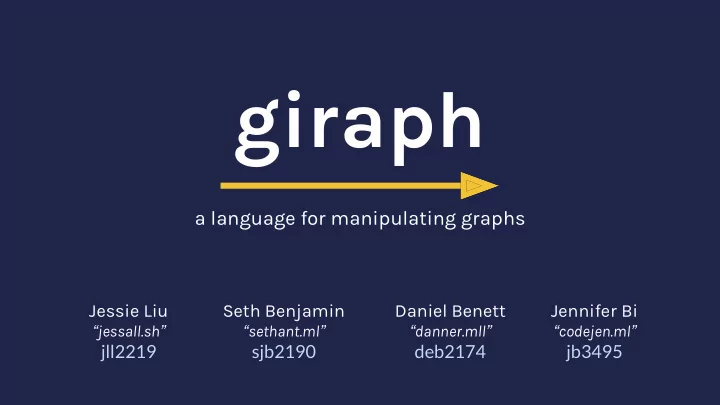

giraph a language for manipulating graphs Jessie Liu Seth Benjamin Daniel Benett Jennifer Bi “ jessall.sh ” “ sethant.ml ” “ danner.mll ” “ codejen.ml ” jll2219 sjb2190 deb2174 jb3495
motivation graph algorithms are everywhere !
project workflow: tools
dec 17: project workflow: timeline sast into codegen dec 16: dec 20: digraphs presenting oct 30: end to end today! hello world! dec 18: nov 17: max flow! dec 2: oct 16: first parsed dec 19: graphs in LRM graph maps! and codegen generic graphs
operators language overview +, -, *, /, %, >, <, >=, <=, ==, : comments control flow !~ this is a for (i = 0; i < 5; i = i + 1) {} comment in giraph while (i > 5) {} ~! if(i == true) {} else {} non-graph types function declarations int, bool, void, int main() {return 0;} float, string, map<int> foo(){map<int> m; return m;} map<>, node
language overview: graphs types syntax graph graph<int> g = [A:1 -- B:2 -- C:3 -- A ; D:4 -- A]; digraph digraph<float> g = [A:1.0 <-> B:2.0 ; E:5.0 <- A]; wegraph wedigraph wegraph<string> g = [A:“hi” -{1}- B:“there”]; wedigraph<int> g = [A:1 -{1}-> B:2 <-{2}- C:3 <-{3}-> D:4];
language overview: graph operations graph methods: add_node(node n) add_edge(node from, node to) remove_node(node n) remove_edge(node from, node to) has_node(node n) has_edge(node from, node to) set_edge_weight(node from, node to, int weight) get_edge_weight(node from, node to) neighbors(node n) print()
language overview: graph iteration for_edge : for_node : graph g = [A:1]; graph g = [A:1 -- B:2]; for_edge(e : g) { for_node(n : g) { print(e.from().data()); print(n.data()); } } bfs : dfs : digraph g = [A:3 -> B:4]; graph g = [A:1 -- C:3; C -- E:5]; bfs(n : g ; B) { dfs(b : g ; C) { print(n.data()); print(b.data()); } }
architecture
architecture implementation: graphs LLVM-side, a graph is represented as a void pointer. This pointer is passed into C library functions. It is a pointer to the head of a linked list of vertex_list_node ’s: struct graph { struct vertex_list_node { struct vertex_list_node *head; void *data; }; struct adj_list_node *adjacencies; struct vertex_list_node *next; };
architecture implementation: edges Edges are represented with an adjacency list. Each vertex_list_node has an adjacency list which contains all nodes it has an edge to. Undirected graphs are represented internally with directed edges in both directions. struct adj_list_node { struct vertex_list_node *vertex; struct adj_list_node *next; int weight; };
architecture implementation: nodes Nodes are also represented as void pointers LLVM-side. This is the node’s data pointer, which points to space allocated C-side that is large enough for any of the potential data types (i.e. sizeof(union data_type)). union data_type { int i; float f; char *s; void *v; };
testing A rule of thumb: At any given point, each new feature in codegen is ● semantically checked. Used regression test suite with target pass/fail test cases, ensure that other ● features still worked. Node and edge data: assignment and access ○ Graph declaration: consistency within graph type ○ Graph iteration ○ Scoping, nesting ○ Maps ○ If necessary, perform manual checks ● E.g., Parser exception => Run programs with ocamlrun’s parser trace ○
testing
edmonds-karp code example Flow network Max s-t flow
demo!
thank you! special thanks to our TA Lizzie
Recommend
More recommend